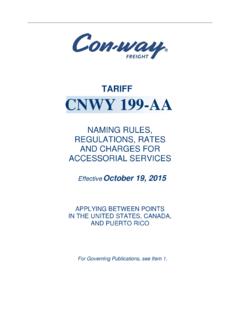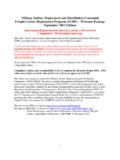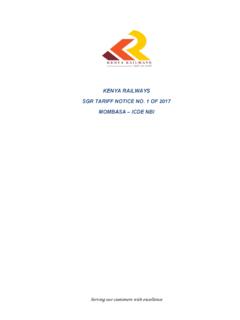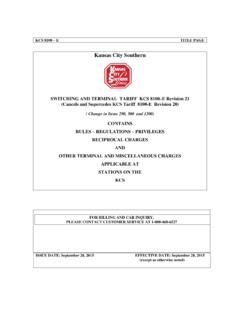Transcription of Freight Transport and Logistics Action Plan
1 Freight Transport and Logistics Action Plan Logistics Initiative for GermanyFreight Transport and Logistics Action Plan Logistics Initiative for GermanyAs at: December 20102 FOREWORD BY THE FEDERAL MINISTERF reight Transport and Logistics Action Plan Logistics Initiative for GermanyDr Peter RamsauerFederal Minister of Transport , Building and Urban Development With the publication of this Freight Trans-port and Logistics Action Plan Logistics Initiative for Germa-ny , we are setting the stage for a sustainable and efficient Logistics and Freight Transport system in doing so, we are implementing a key objective of the Federal Government s Transport policy. This objective involves facilitating the smooth trans-port of goods, and thus creating the conditions for growth and employment, without losing sight of the environmental protection and climate change aspects. If we are to achieve this, we need an efficient and environmentally sound Transport system in which the individual modes of Transport are interlinked in an optimum manner and can deploy their inherent strengths.
2 In this context, the rail and waterway modes play an important role. Levels of Freight traffic will rise sharply in the future, and it is our aim to transfer as much of this traffic as possible to these Germany, as an exporting nation, efficient and environmentally friendly Freight Transport and modern infrastructure represent a crucial factor for success in international competition. As a centre for Freight Transport and Logistics , Germany was recently rated by the World Bank as being the leading country not only in Europe but in the world. This is something of which the German Transport industry, in particular, can be proud. However, for me, as the Federal Minister of Transport , this is also an incentive to further strengthen and evolve this important sector of the economy. And there is a good reason for doing so. With a turnover of more than 200 billion euros in 2009, Freight Transport and Logistics are the third largest sector of the economy in our country. This sector employs million people.
3 Their jobs are to remain secure and attractive in the future. This is all the more necessary against the back-ground of the financial and economic crisis. It has left its mark on the Freight Transport industry, as it has on other export-driven sectors. Fortunately, in the second half of 2010, a significant upturn is now apparent at present Action Plan realigns the Federal Government s Freight Transport and Logistics Masterplan, which was prepared in the last parlia-mentary term, to address the current challenges. On this basis, we will, with a new, very concrete development strategy, create the conditions for strengthening Germany as a Freight Transport and Logistics centre in international competition in an environmentally sound manner and permanently securing the jobs in this sector. As we continue to implement the Action Plan, we also have to take into account the budgetary con-straints on the Federal Government and the limit imposed on public borrowing by the Basic Law. That is why it is important to establish priorities.
4 And that is exactly what this Action Plan does. Given the huge efforts that are being made to con-3 FOREWORD BY THE FEDERAL MINISTER solidate the budget, I am especially pleased that we have managed to keep investment in Transport infrastructure at a high level. Efficient Transport infrastructure is the lifeblood of our economy, and thus one of the major prerequisites for the prospe-rity of our country. I would like to take this opportunity to say a big word of thanks to Parliamentary State Secretary Dr Andreas Scheuer who, as the Federal Government Coordinator for Freight Transport and Logistics , has overseen the development of the Action Plan with a high degree of personal commitment. My thanks also go to all those who actively participa-ted in this development by making suggestions and contributing to the discussions. I hope that we will be able to jointly continue this cooperation, which has been constructive and conducted in a spirit of trust, in the forthcoming implementation of the forces with the private sectorto promote good Logistics in GermanyDr Andreas ScheuerParliamentary State Secretary at the Federal Ministry of Transport , Building and Urban Development and Federal Government Coordinator for Freight Transport and Logistics The Coalition Agree-ment between the Christian Democratic Union (CDU), Chris-tian Social Union (CSU) and Free De-mocratic Party (FDP) includes the objective of strengthening Germany as a centre for Logistics by joining forces with the private sector and realigning the Freight Transport and Logistics Masterplan.
5 This has involved adapting the Masterplan, which was adopted two years ago, to address the current conditions. But above all it has involved a strate-gic readjustment. The guiding principle of this Federal Government is to facilitate mobility rather than hampering it. In the interests of a forward-looking Freight Transport policy, we must ensure that the Transport of goods is efficient, environ-mentally sound and multimodal. In this context, the railways and waterways have a major role to play. They have to be able to accommodate as much Freight traffic as possible in order to reduce congestion on the roads. In addition, we have to improve the regulatory framework and continue to consolidate the advantages of Germany as a centre for Logistics . In this context, the individual measures are described in as concrete and practi-cal terms as possible. In addition, we were keen to no longer just put them side by side, but to allocate clear priorities to them. The Action Plan that has now been published is the outcome of an intensive process of discussion with the private sector, the aim of which was to develop a Logistics initiative for Germany that is supported by all stakeholders.
6 For this reason, companies and trade associations were included in the process of realignment from the outset and all sugges-tions and criticisms were discussed, considered and, wherever possible, taken into account in a transparent and open dialogue. This was not always easy and occasionally resulted in heated discussions. Nevertheless, the process was always characterized by mutual understanding and a dedicated search for solutions. What we now have is a streamlined and concrete Transport policy framework for Action in the Freight Transport and Logistics sector. This Action Plan will help to secure the productivity of Germany as a competitive site for industry and to successfully exploit opportuni-ties for growth. The outcome of the dialogue was that a total of 30 measures were defined, which have been included in the Action Plan. These measures are geared to the Federal Government s five key objectives in shaping Freight Transport and Logistics and have been allocated to these objectives in terms of their subject matter.
7 The objectives are: strengthen Germany as a centre for Logistics ; enhance the efficiency of all modes of Transport ; exploit the strengths of all modes of Transport by interlinking Transport infrastructure in an opti- mum manner; promote the compatibility of traffic growth with measures to protect the environment and tackle climate change; support good conditions of working and training in the Freight Transport package of measures is allocated to each ob-jective. Those measures which, in the light of the current economic and financial crisis, are consi-dered especially important for the development of Germany as a centre for Logistics are to be given priority in implementation. These include, among others, the implementation of the Natio-nal Ports Strategy and relevant parts of the Federal Government s 2009 Airports Strategy, in order to gear the major Transport hubs to the future growth in the level of Freight traffic. Another priority project is the optimization of roadworks management on federal motorways to improve the flow of traffic.
8 In the field of co-modality, an important role is played by combined Transport , without which a major contribution to the reduc-tion of CO2 emissions would not be the Freight Transport and Logistics Action Plan, each individual measure is an important compo-nent of a fine-tuned overall strategy. The aim of this strategy is to strengthen the modes of trans-port and enable them to exploit their inherent advantages. In addition, it is necessary to create multimodal interchanges in order to establish smooth Transport operations. In this way, it will also be possible to generate more traffic for the railways and waterways. Wherever necessary, new measures were added to the framework for Action . This applies, for in-stance, to the nationwide field trialling of longer goods vehicles , by means of which we wish to stu-dy the economic, ecological and Transport impacts of these vehicles. Not until these knock-on effects are known will it be possible to take a responsible decision as to whether the permanent approval of these vehicles, in conformity with EU legislation that would have to be amended, would be bene-ficial.
9 In addition, nationwide field trialling of Freight trains longer than 750 metres is designed to identify possibilities for making more effici-ent use of existing capacity on the railways. This can make a major contribution towards shifting more Freight traffic to the railways. We have also included an analysis of the potential for multimo-dal Transport , the findings of which are to be used to optimize Freight Transport chains with a view, among other things, to achieving a modal shift. The study entitled Optimizing Transit Traffic , whose focus on reducing unnecessary journeys was rightly criticized, has been recast with the aim of developing measures to improve long-distance Freight Transport operations. On the other hand, given the changed situation, it is possible to totally discontinue some of the measures in the Freight Transport and Logistics Masterplan. This applies, for instance, to the formulation of a strategy for the internalization of external costs. Here, the Federal Government believes it is up to the European Commission as part of its activities to amend the Infrastructure Charging Directive to present an appropriate concept that includes all modes of Transport and treats them according to the same criteria.
10 Nor will the review, envisaged in the Master-plan, to evaluate the regulatory framework for Freight Transport be pursued any further. To this end, the Federal Government has made binding commitments on the basis of the Coalition Agree-ment. This applies in particular to the user pays principle and infrastructure charging. Thus, we will strengthen the mode-specific closed funding cycles . For the roads, we intend to introduce such a cycle as early as 2011. All revenue from HGV tolls will then be ringfenced to fund the federal trunk roads. This also applies to the toll revenue that will be generated by the planned extension of tolling to federal highways with four or more lanes. In addition, we have revoked the increase in toll rates for EURO III vehicles. In the rail sector, we are currently undertaking a comprehensive review of the multiplicity of regulatory provisions. This also concerns, in particular, issues relating to the user pays principle, such as the rules governing charging and access to the network and service the years ahead, enhancing the efficiency of the overall Transport network and co-modality 6 FOREWORD will be at the forefront of our policy.




